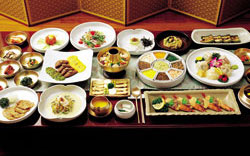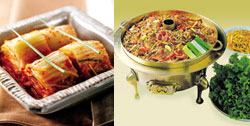
Traditional full-course meal
Of the three basic elements of life ― house, clothing and food ― the change in dietary habits has most significantly affected Koreans.
Rice still remains the staple of most Koreans, but among the younger generations, many prefer Western-style food.
Rice has been usually accompanied by various side dishes, mostly seasoned vegetables, soup, pot stew, and meat.
A traditional Korean meal is not complete without kimchi, a mixture of various pickled vegetables such as Chinese cabbage, radish, green onion and cucumber. Certain types of kimchi are made spicy with the addition of red chili pepper powder, while others are prepared without red chili peppers or are soaked in a tasty liquid. However, garlic is always used in kimchi to add to its flavor.
In late November or early December, Korean families used to prepare enough kimchi to last the long winter. The kimchi was stored in large clay jars partially buried to maintain temperature and retain flavor.
In modern Korea, housewives often don't have time to make kimchi or the outdoor space needed to store large amounts. But kimchi is still a vital part of the Korean lifestyle: companies making the fermented dish and others selling special kimchi refrigerators enjoy brisk sales.

Baechu Kimchi (left) and Bulgogi, Korea's most popular beef dish (right)
In addition to kimchi, doenjang (soybean paste), with its anti-cancer attributes, has attracted the attention of modern-day nutritionists. Koreans used to make doenjang at home by boiling yellow beans, drying them in the shade, soaking them in salty water, and fermenting them in sunlight. However, only a few families go through this process anymore; the majority buy factory-made doenjang.
Among meat dishes, seasoned bulgogi (usually beef) and galbi (beef or pork ribs) are the most favored by both Koreans and foreigners.